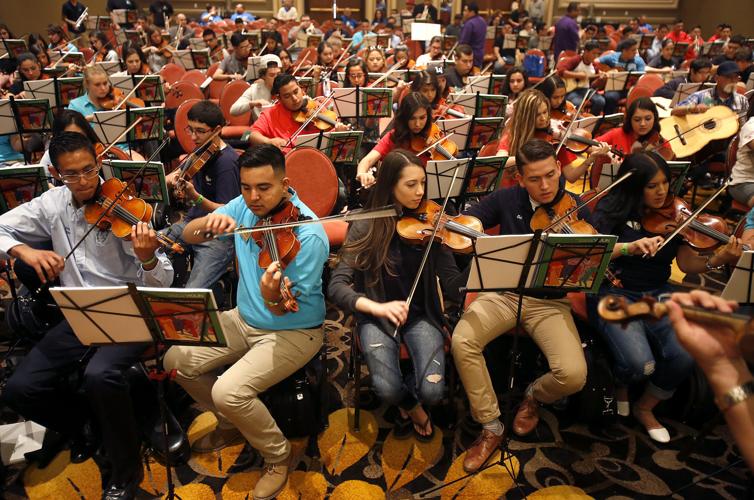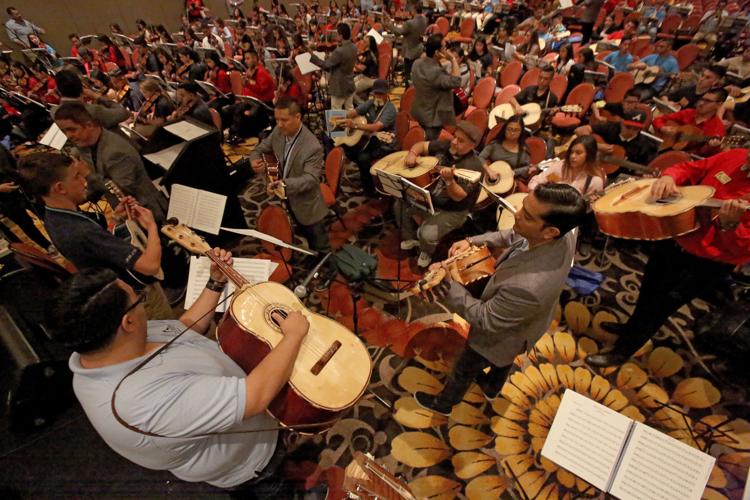Living in Tucson means that, on any given weekend, you can hear mariachi music being performed somewhere. At a restaurant, at a Catholic Mass or at a celebration of some kind, we enjoy the rapture of violins, guitars and vihuelas, trumpets and that deep-bodied bass guitar, the guitarrón.
Mariachi music has been an integral cultural component in Tucson and Southern Arizona for decades.
But elsewhere — including in Mexico, where the music was born and is considered part of its patrimony — mariachi music is slowly disappearing.
Case in point: At Thursday’s 17th Latin Grammy awards program, the ultimate celebration of Latin music worldwide, no award was given in the mariachi/ranchera category. The Latin Recording Academy said there were not enough nominations.
“We started raising alarm bells with years of anticipation to say, ‘This genre is going down,’” Gabriel Abaroa Jr., president of the Latin Recording Academy, told The Associated Press. “When we start to detect that there are fewer, fewer and fewer inscriptions, what we do is shout, sound the alarm.”
There is less commercial demand for the music; it doesn’t sell compared to other Latin genres, even in Mexico where the regional norteño music is more popular. And there are fewer younger artists to replace the singing legends of música ranchera: Jose Alfredo Jimenez, Lola Beltran, Javier Solis, Lucha Villa, Pedro Infante.
And with the retirement of Vicente Fernandez, a giant in the industry, and the recent death of singer-songwriter Juan Gabriel, whose songs are in every mariachi’s repertoire, the genre’s cupboard is bare.
That hurts even more because mariachi music is not just a symbol of Mexican culture, but is considered a worldwide gem. Five years ago UNESCO, the cultural and educational arm of the United Nations, declared mariachi music an Intangible Cultural Heritage of Humanity. The world body urged that the music be preserved and promoted.
The mariachi world welcomed the global recognition with some faint hope that the music’s slow demise might be reversed. Apparently, the music’s popularity continues to erode.
As a lifelong lover of mariachi and ranchera music, I am saddened that this beautiful, meaningful and traditional music is slipping by us. But as a Tucsonense, a homeboy, my spirits are lifted by Tucson’s role in fomenting the growth of the music and widening its reach.
Tucson is the birthplace of youth mariachi groups and mariachi conferences. It’s the hometown of musicians, singers and composers who have contributed to the mariachi tableau.
Start with Eduardo “Lalo” Guerrero, who was born 100 years ago next month in Barrio Viejo. Lalo, as he was best known, was a pioneering Chicano singer-composer who began promoting Mexican music, including mariachi, before World War II. But his most influential contribution was his songwriting, specifically two songs. His compositions “Nunca Jamás” and “Canción Mexicana” are staples in the Mexican songbook. Moreover, “Canción” is considered Mexico’s unofficial anthem. Lalo’s life and music will be celebrated Dec. 9 at the Casino Ballroom.
After the war, Tony Garcia and Carlos Saldivar Sr. formed Mariachi Tucsonense, probably the first in Tucson. In 1964, Los Changuitos Feos became Tucson’s first youth mariachi ensemble. The group continues today and has fostered the growth of high school mariachi programs here and elsewhere.
In addition, graduates of Tucson’s youth groups have become professional mariachis and music educators here and in California, Nevada and other states.
In 1983, Tucson midwifed a mariachi lover’s dream: an annual festival. La Frontera Tucson International Mariachi Conference has brought thousands of students, teachers, folklorico dancers and fans to Tucson, and generated similar conferences in the U.S. and Mexico.
Four years later, Tucson-born singer Linda Ronstadt, who had performed at an earlier mariachi conference, rocked the mariachi world with “Canciones de Mi Padre,” a lush ode to the music she grew up listening to with her father, Gilbert Ronstadt, and a Ronstadt family friend, Lalo Guerrero. The record remains a cultural touchstone.
The sound may be lessened elsewhere, but a new generation of Tucson musicians and singers continues to cultivate mariachi music.





